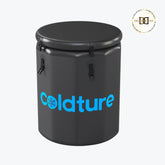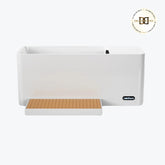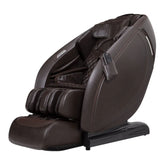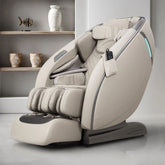Saunas have been an integral part of human culture and well-being for centuries. These heat therapy chambers have evolved over time, and today, there are various types of saunas available, each with its unique characteristics and benefits.
While much of the research pertaining to the benefits of sauna have been conducted using traditional saunas, infrared saunas, and steam saunas also offer the heat stimulus or heat stress that is great for our health on so many levels.
Here, we will delve deep into the differences between these three types of saunas, explain their subtle differences including their operating temperature, how they function, discuss the typical duration to aim for, and provide an extensive overview of their respective health benefits, substantiated by scientific studies.
Benefits of Sauna Use
Enhanced Detoxification Pathways
Our body employs various mechanisms to rid itself of toxins and heavy metals. Among these, our skin, our largest organ, plays a significant role by aiding detoxification through sweat.
As one study highlights, "an often overlooked route of excretion of toxicants is via the process of sweating." With the growing prevalence of chemical exposure in our lives, sweat serves as a means to eliminate harmful substances, including heavy metals like lead, mercury, and arsenic.
Accelerated Muscle Recovery and Endurance
For those grappling with post-workout muscle soreness, sauna sessions can expedite the recovery process, particularly after endurance training.
While the benefits for maximum lifts and heavy lifting are less pronounced, sauna use can significantly enhance endurance performance, as evidenced by studies indicating a remarkable 30% increase in run time to exhaustion.
Muscle Growth and Heat Shock Proteins
Sauna use isn't just about relaxation; it can also contribute to muscle growth.
Research shows that hyperthermia induced by sauna sessions can elevate heat shock protein expression, fostering muscle regrowth in response to exercise-induced micro-injuries.
Elevation of Growth Hormones
The relationship between sauna use and growth hormone release is intriguing. The extent of growth hormone release varies based on factors such as time, temperature, and frequency.
For instance, two 20-minute sauna sessions at 80°C (176°F), separated by a 30-minute cooling period, can double growth hormone levels.
Conversely, two 15-minute sauna sessions at 100°C (212°F), with cooling intervals, can result in a five-fold increase in growth hormone levels.
Enhanced Insulin Sensitivity
Poor insulin sensitivity can lead to weight gain, inflammation, and diabetes.
Sauna-induced hyperthermia has been shown to improve insulin resistance, making it a valuable tool for individuals dealing with diabetes and insulin-related weight issues. Improved insulin sensitivity is a key factor in achieving metabolic health.
Augmented Nitric Oxide Bioavailability
Nitric oxide (NO) plays a pivotal role in vasodilation, enhancing blood flow to muscles and serving various other important functions in the body.
Sauna use has been found to increase NO bioavailability, promoting better blood circulation and potentially benefiting both men and women, including potential benefits for sexual health in men.
Heat Acclimation and Improved Performance
Exposing the body to heat stressors, similar to sauna conditions, can enhance one's ability to perform in hot and humid environments.
A study involving female athletes demonstrated improvements in thermoregulation, cardiovascular function, and perceived strain after five days of sauna-like heat exposure, with daily sessions lasting 20 minutes.
Caloric Burn and Weight Management
Sauna sessions naturally burn calories due to the thermogenic effects of the heat. As we sweat to cool down our bodies, we expend calories in the process.
However, it's important to note that the weight loss following sauna use primarily consists of fluids. Proper hydration before, during, and after sauna sessions is essential.
Pain Reduction and Increased Beta-Endorphins
Sauna use can stimulate the release of beta-endorphins, natural pain-relieving compounds.
Studies suggest that sauna-induced stress responses trigger the production of beta-endorphins, contributing to pain reduction.
This effect extends to headache relief, making sauna bathing a potentially effective treatment for reducing headache intensity.
Improved Sleep Quality
Raising your body temperature in a sauna session just before bedtime can help induce deeper sleep.
The body's post-sauna cooling and normalization process can facilitate a calm and relaxed state conducive to sound sleep throughout the night.
Positive Impact on Brain Health
Research reveals several promising aspects of sauna use for brain health, including reduced risk of cardiovascular disease and all-cause mortality, as well as a decreased likelihood of developing dementia and Alzheimer's disease.
Sauna sessions, known for promoting relaxation and well-being, may be a valuable intervention for preserving cognitive health in healthy adults.
Social Benefits of Sauna
While not rooted in science, the social aspect of sauna sessions should not be overlooked. Saunas have served as venues for diverse and meaningful conversations.
Sharing a sauna with others, whether one or twenty individuals, provides an opportunity for engaging discussions, often resulting in problem-solving and bonding.
Extended Lifespan
For those seeking to maximize both the quality and quantity of life, frequent sauna use offers promising benefits. Studies indicate that increased sauna frequency is associated with a reduced risk of all-cause mortality. For instance, men who use the sauna two to three times weekly were found to be 27% less likely to die from cardiovascular-related causes than those who did not.
Enhanced Sense of Well-Being
Endorphins, often referred to as the "feel-good" hormones, play a crucial role in mood enhancement. Just as a rigorous workout can elevate your mood, sauna sessions have a similar effect.
Recent studies suggest that whole-body hyperthermia, such as that induced by sauna use, holds potential as a safe and rapid-acting antidepressant modality with lasting therapeutic benefits.
Additionally, sauna use can reduce the stress hormone cortisol, contributing to an overall sense of well-being.
Comparative Analysis of Sauna Types
The choice between traditional, infrared, and steam saunas largely depends on individual preferences, health goals, and tolerance for heat and humidity. Below, we provide a comparative analysis of these three sauna types:
-
Temperature: Traditional saunas operate at the highest temperatures, followed by steam saunas, while infrared saunas run at lower temperatures.
-
Humidity: Steam saunas have the highest humidity levels, traditional saunas have the lowest, and infrared saunas fall in between.
-
Duration: Steam sauna sessions tend to be longer, while traditional sauna sessions are relatively shorter. Infrared saunas have a moderate duration.
-
Heat Penetration: Infrared saunas penetrate the body with radiant heat, traditional saunas heat the air around you, and steam saunas envelop you in moist heat.
-
Health Benefits: All three types of saunas offer various health benefits, but the specific benefits may vary. Traditional saunas are often associated with cardiovascular benefits, infrared saunas with pain relief, and steam saunas with respiratory health.
-
Tolerance: Individual tolerance for heat and humidity plays a significant role in determining which sauna type is suitable for a person. Some may find traditional saunas too hot, while others may prefer the intense heat.
Far Infrared, Near-Infrared, and Full Spectrum
When it comes to infrared saunas, not all wavelengths are created equal. Beyond variations in size, style, and cost, the primary distinction among different types of infrared saunas lies in the wavelengths they emit.
The infrared light spectrum encompasses near-infrared, middle-infrared, and far-infrared wavelengths, each offering its unique set of advantages.
-
Far-Infrared:
-
Wavelength Penetration: Far-infrared wavelengths penetrate the deepest into the body, extending beyond the skin's surface. This makes far-infrared saunas a preferred choice for those seeking potent healing benefits.
-
Middle-Infrared:
-
Inflammation Reduction: Middle-infrared wavelengths are believed to aid in reducing inflammation within the body.
-
Enhanced Circulation: They may also contribute to improved blood circulation.
-
Near-Infrared:
-
Surface-Level Effects: Near-infrared wavelengths predominantly affect the skin's surface, potentially offering unique benefits related to skin healing.
-
Full Spectrum:
-
Comprehensive Healing: Full spectrum infrared saunas, often equipped with distinct heating elements, emit all three types of wavelengths. This comprehensive approach combines the benefits of far-infrared, middle-infrared, and near-infrared wavelengths, offering a diverse range of potential health advantages.
The choice between far-infrared, near-infrared, or full spectrum infrared saunas depends on individual wellness goals, as each wavelength type addresses specific aspects of health and healing.














